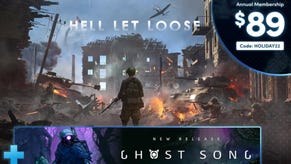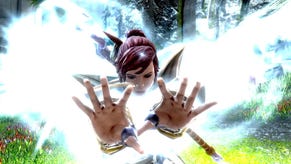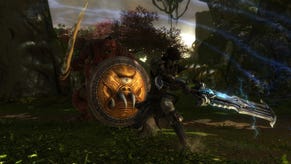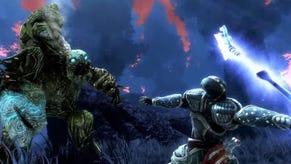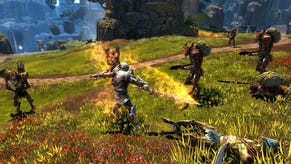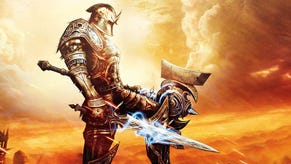A force to be reckoned: Hands-on with Amalur: Reckoning
EA is aiming to show why you shouldn’t judge a game by its genre with this action-RPG hybrid. Hands-on impressions and words from EA’s Ben Smith.
Thursday morning seems as good a time as any to have an existential discussion, so: do you believe in fate? Do you believe that, regardless of your actions, you will be led to one particular spot at one specific time? That your path is already determined and that your life is lived within a framework that’s been mapped out by a higher being or woven into the fabric of some greater master plan?
I do not, but that’s neither here nor there. What’s relevant is that in Kingdoms of Amalur: Reckoning, 38 Studios and Big Huge Games presents a world full of fates and destinies but casts you as a fateless hero, capable of defining who you are through your actions and affecting both the narrative and gameplay experience.
Several of the themes I see during the two hours spent with Reckoning are enough to suggest that this could be more than just a mash-up of “Fable-meets-God-of-War”, as some commentators have lazily described it.
Take character creation, for example: amongst the otherwise expected choice of race, appearance and gender is the requirement to pick a god with which you align yourself. The various choices confer different bonuses or gifts but you can also choose to follow no god. This choice bestows a 10 percent bonus to all XP earned, suggesting the game recognises that you are firmly choosing to define yourself through your own actions, not faith in another.
Elsewhere, concepts such as racism, ideology and fascism are addressed, but not shoved down your throat in laboured cut scenes or as the subject of didactic sermons delivered by central characters. Instead, they crop up in optional side quests and, much like the concepts of fate and destiny that are central to the over-arching plot, you can choose to invest yourself in the underlying reasons for your actions as little or as much as you want as you go about these additional duties.
When presented with a member of the elfin Fae who has been beaten to within an inch of her life for sport, will you carry out the subsequent fetch quest for the XP alone? Or will you consider how the gawping group of spectators that gather in the aftermath of the assault cannily reflect the morbid curiosity and crowd mentality seen in the real world?
It’s these component concepts of Reckoning’s world that stimulate my interest as I play. The main story about a rising evil, a chosen hero and their task to save the world is common enough fare, but the more relatable concepts lend weight to a world that exceeds the cheerfully colourful aesthetics that comic-book artist Todd McFarlane has contributed to.
Fight club
The combat system continues the theme of rewarding investment. Surprisingly fluid and dynamic for what otherwise appears to be a sedately-paced RPG adventure, it looks set to be the headline feature: the shiny treasure that might lure otherwise reticent players into this deceptively action-heavy experience. In fact, that’s something that EA is counting on.
“I’d describe Reckoning as an RPG with ‘Best-in-Class’ combat; I don’t think anyone in our space has done combat like this,” states a confident Ben Smith, EA Partners producer.
“That’s really as a result of the discoverable combos and the fact that you can flawlessly switch between weapons and magic. When you add in the fluid animations, you really feel like you’re down with the combat. Yes, I can say without reservation that I think that we do combat better than anyone has managed so far.”
"I can say without reservation that I think that we do combat better than anyone has managed so far."
It would be easy to dismiss Smith’s words as so much bluff and bluster, well rehearsed lines by a man with an interest in selling the concept of the game to as many potential genre fans as possible. However, investing a significant amount of time into the combat during my two-hour session, the depth that Smith alludes to is often glimpsed.
Kitting out a character with both primary and secondary weapons is all that’s required to prime them for combo opportunities. By varying the timing of attacks, a number of different effects can be achieved and whilst straight-up button mashing will see you through lower-level enemies safely enough, more complex strategies yield more impressive results and bigger XP bonuses.
“The combat system is built on being able to interrupt moves,” explains Smith “So, where you combo the weapons is dynamic and up to you. There are no built-in combos but there are definitely combos that work particularly well together.
“My favourite examples usually involve launching an enemy. So, perhaps you’re equipped with daggers and a bow and if you invested enough points in the skill you can dodge an attack and then, out of that dodge, you can do a launch attack on your enemy. Once they’re in the air, you can switch to your bow and juggle the guy until you run out of ammo or jump in with more melee moves.”
In truth this is one of the simpler combos, and more can be achieved by mixing standard attacks with magic or area of effect abilities. Results also vary depending on your choice of affiliation with armed-combat, magic or finesse.
Do you want to be in my gang?
The game’s three human factions fit the three basic classes available. The Warsworn are heavily armed fighters with aggressive combat abilities, the Scholia Arcana are warrior-mages who can comfortably engage in melee combat bolstered by spells for both attack and defence and the Travellers are shadowy rogues, capable of catching enemies unawares and delivering fatal strikes when the enemy is vulnerable.
The lines between these three can be blurred by the use of skill trees and destinies. The skill trees are entirely visible from the start, so you can map out which abilities you’d like to obtain from each tree ahead of time.
The destinies are both a narrative and gameplay device that informs the style in which you are playing, or would like to play. It’s possible to pick destinies that focus purely on one area, such as magic, or to slightly dilute the power of that magic by mixing it with a warrior or rogue destiny. In this way, many higher level characters will either be a mix of all three disciplines of magic, stealth and combat, focus on just two of these or even plough all of the upgrade points into one path to be pure mage, rogue or warrior.
At a time when many RPGs are looking to break from the traditional class-based levelling structure, it’s good to be reminded that a few focused ideas surrounding class-progression can be as rewarding or refreshing as doing away with classes entirely.
Sitting down to write my impressions of Kingdoms of Amalur: Reckoning, I find I’m more impressed than I expected to be. On closer inspection, what appears in trailers and static screens to be another generic RPG looks to have the potential to deliver much more. There’s no denying that the game’s combat feels like it should be played with a controller, not a keyboard and mouse, though how the interface would hold up over scores of hours is another matter.
Whether you believe in fate or not, it seems that Reckoning is shaping up to give itself every chance to define its own path and be judged on its own merits rather than have its destiny decided by other big hitters in the same genre. Be wary of dismissing it before looking a little closer; as with so many of its concepts you may find that a little investment is significantly rewarded.
Kingdoms of Amalur: Reckoning is due out on PS3, 360 and PC in February 2012.





